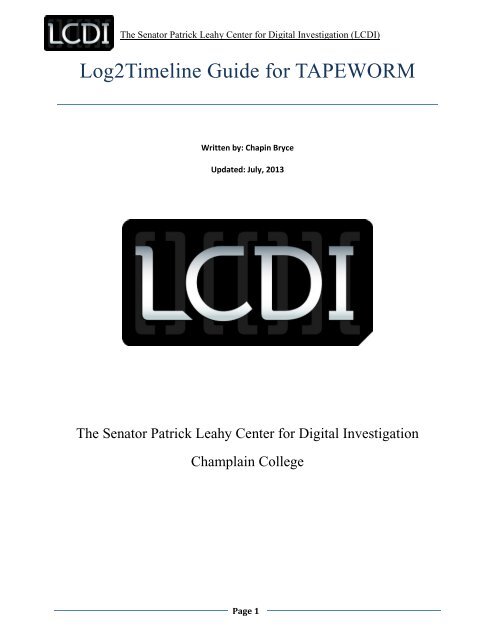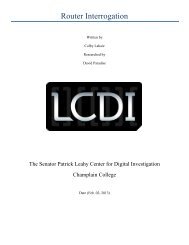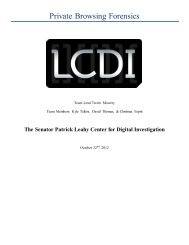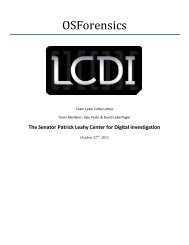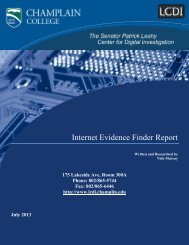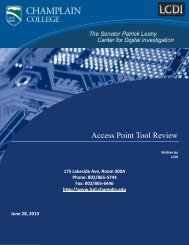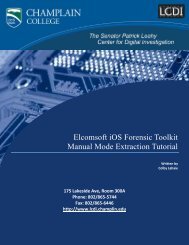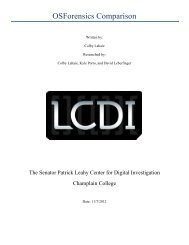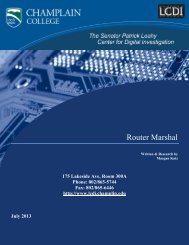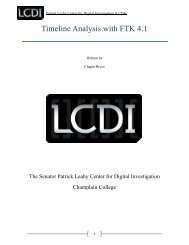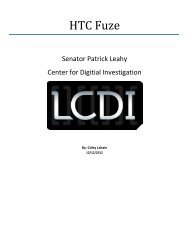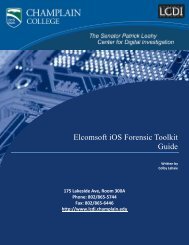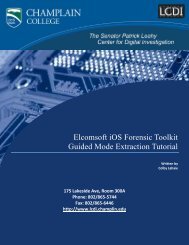Log2Timeline Guide for TAPEWORM - Computer Forensics At ...
Log2Timeline Guide for TAPEWORM - Computer Forensics At ...
Log2Timeline Guide for TAPEWORM - Computer Forensics At ...
Create successful ePaper yourself
Turn your PDF publications into a flip-book with our unique Google optimized e-Paper software.
The Senator Patrick Leahy Center <strong>for</strong> Digital Investigation (LCDI)<strong>Log2Timeline</strong> <strong>Guide</strong> <strong>for</strong> <strong>TAPEWORM</strong>Written by: Chapin BryceUpdated: July, 2013The Senator Patrick Leahy Center <strong>for</strong> Digital InvestigationChamplain CollegePage 1
The Senator Patrick Leahy Center <strong>for</strong> Digital Investigation (LCDI)Table of ContentsConfiguring <strong>TAPEWORM</strong> <strong>for</strong> <strong>Log2Timeline</strong> ................................................................................................... 3Running <strong>Log2Timeline</strong> in <strong>TAPEWORM</strong> .......................................................................................................... 4Reading the output from <strong>TAPEWORM</strong> ......................................................................................................... 6Page 2
The Senator Patrick Leahy Center <strong>for</strong> Digital Investigation (LCDI)Configuring <strong>TAPEWORM</strong> <strong>for</strong> <strong>Log2Timeline</strong><strong>TAPEWORM</strong> is a… and can be downloaded at:http://tapeworm.s3.amazonaws.com/<strong>TAPEWORM</strong>_1.1.2013_Jan_17.vmware7vm.zip.Once the zip file <strong>for</strong> <strong>TAPEWORM</strong> is downloaded and unzipped, it can be opened in VMWare Workstation7, 8, 9,;VMWare Fusion; or VMWare Player, 3, 4, or 5. Additionally, it can be converted <strong>for</strong> use withVirtualBox ( using the latest version of any software is recommended). Once it has been opened in thevirtualization product, VMWare (shown in Figure 1) can be configured <strong>for</strong> the host machine.Figure 1 – <strong>TAPEWORM</strong> VM in VMWare Workstation 9.0.2Opening the “Edit virtual machine settings” window allows the user to change the number ofprocessors, amount of RAM, and shared folders to be configured <strong>for</strong> use. The recommendedspecifications are preset into the virtual machine. Figure 2 shows the shared folder configuration.Page 3
The Senator Patrick Leahy Center <strong>for</strong> Digital Investigation (LCDI)Figure 2 – Shared Folder ConfigurationRunning <strong>Log2Timeline</strong> in <strong>TAPEWORM</strong>Once the virtual machine is running, the desktop will show the main tapeworm window (See Figure 3).From this interface, the automated graphic user interface (GUI) can be used, and the preprocessing andtimeline creation <strong>for</strong> any exhibit can begin. It should be noted that if the main window is minimized,other tools may be accessed either from the terminal or separate GUI applications from the desktop.Figure 3 – <strong>TAPEWORM</strong> InterfaceAs seen in Figure 4, the <strong>TAPEWORM</strong> interface has case options that need to be filled out in regards tothe specific case being processed. After filling out case details, select the evidence type. For creating atimeline, the disk image option is most often used due to the E01, DD, or AFF files used to acquirePage 4
The Senator Patrick Leahy Center <strong>for</strong> Digital Investigation (LCDI)Figure 5 – <strong>TAPEWORM</strong> Mount LogFor the test image used in this tutorial (FIRE 04192013.E01), <strong>TAPEWORM</strong> was able to create a timeline in25 hours and 17 minutes. It is important to note that this exhibit had 3 operating systems installed:Windows 7, Mac OSX, and BackTrack Linux. Each of these Operating Systems runs on a separate timezone, each with unique user data. If the 25 hour and 17 minute run may seem extremely long, note that<strong>TAPEWORM</strong> ran <strong>Log2Timeline</strong> against every partition in the correct time zone, as well as in every <strong>for</strong>mattype in one instance without the use of a single command.Once the timeline is completed, a new folder can be found in the output directory containing anorganized (by tool) output. Inside the log2timeline directory are the file types and logs <strong>for</strong> runninglog2timeline, with the partition offset in the file names. <strong>TAPEWORM</strong> exports the timelines in CSV,bodyfile, mactime, or TLN <strong>for</strong>mats. The CSV <strong>for</strong>mat is fairly common and can be opened with MicrosoftExcel or any other spreadsheet program. The bodyfile and mactime <strong>for</strong>mat can be used with the SleuthKit and other open source <strong>for</strong>ensic tools <strong>for</strong> timeline analysis. The TLN <strong>for</strong>mat is a custom <strong>for</strong>mat thatcan function with Harlan Carvey’s tools.Reading the output from <strong>TAPEWORM</strong>For this guide, the CSV files will be used to look at the output. In <strong>TAPEWORM</strong>, the CSV documents aresplit when they are too large <strong>for</strong> excel to open, preventing any error <strong>for</strong> maximum file size. Also in theoutput folder are two different CSV files, one with modules and one without. <strong>TAPEWORM</strong> adds anadditional column to the Log2timeline CSV output, to include the module used to process the particularartifact. For example, if the artifact listed in the CSV file originated from an index.dat file, the index.datwill be listed in the module column. This seems to be a lot of extra in<strong>for</strong>mation, but when per<strong>for</strong>ming aninvestigation and attempting to look into specific in<strong>for</strong>mation such as a timeline of Firefox history,sorting by module becomes extremely helpful. The CSV files will also contain the data within anyspecified date range, while the other file types do not allow <strong>for</strong> that sort of filtering. The CSV will be themost accurate source of in<strong>for</strong>mation.Page 6
The Senator Patrick Leahy Center <strong>for</strong> Digital Investigation (LCDI)Opening the CSV files in Microsoft Excel shows the data neatly organized by column: sorted by date andtime from oldest to newest (See Figure 6). Using Excel’s data sort feature, the first row can be used tosort and filter content throughout the document.Figure 6 – CSV Timeline OutputTo enable the sorting feature, select the “data” tab in excel (See Figure 7).Then select filter (See Figure 8).Figure 7 – Data Filtering with ExcelFigure 8 – Applying a Data Filter in ExcelPage 7
The Senator Patrick Leahy Center <strong>for</strong> Digital Investigation (LCDI)Page 8


